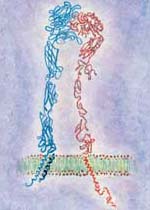| > |
Researchers at the University
of Pennsylvania School of Medicine have designed
peptides that are able to bind to specific regions of transmembrane
proteins, using computer algorithms, and information from
existing protein sequence and structure databases. |
| > |
In the future, this knowledge can provide
insights for identifying novel drug targets. |
| > |
The researchers targeted two transmembrane proteins called
integrins that influence the behavior of platelets, small
blood cells important in clotting. When the designed peptide
is inserted into the platelet membrane it binds to the portion
of the integrin within the membrane, and subsequently perturbs
another function in the clotting process downstream. |
| > |
This study appears in the March
30 issue of Science. |
(PHILADELPHIA) – Proteins, which form much of the molecular machinery required for life, are the targets of most drug molecules.
One third of all proteins are membrane proteins – embedded
within the cell’s fatty outer layer. While scientists can
easily study the other two-thirds using such tools as antibodies,
they have not had such methods to investigate the membrane-embedded
portions of proteins.
 |
Artist rendering of integrin transmembrane protein
Click on thumbnail
to view full-size image |
To probe the secrets of these seemingly inaccessible proteins,
researchers at the University of Pennsylvania
School of Medicine have designed peptides that are able to bind to specific regions of transmembrane proteins,
using computer algorithms, and information from existing protein
sequence and structure databases. This study, which appears in
the March 30 issue of Science, looks at how the
binding of these designed peptides affects the crucial first steps
in blood
clotting.
“We can now actually interrogate parts of proteins within
the membrane,” says senior author William
F. DeGrado, PhD,
Professor of Biochemistry
and Biophysics. “We used computer
programs to design small proteins called peptides that can bind
to only one of a number of closely related membrane proteins.”
The researchers targeted two transmembrane proteins called integrins that influence the behavior of platelets, small blood cells important
in clotting. One of these, the αIIbβ3 integrin, the
most prominent integrin on platelets, is involved in making platelet
aggregates, an important first step in the clotting process.
The other integrin, called αVβ3, behaves much like αIIbβ3,
in that it causes platelets to stick to certain proteins on the
outside of the cell. “We wanted to see if we could differentiate
between the two integrins using two different peptides – and,
in fact, we can,” notes co-senior author Joel
Bennett, MD,
Professor of Medicine, who works with proteins and cells important
in clotting.
When the designed peptide is inserted into the platelet membrane
it binds to the portion of the integrin within the membrane, and
subsequently perturbs another function in the clotting process
downstream. “By having molecules that bind to the membrane-embedded
portions of these proteins, we were able to address questions concerning
the way that these proteins are regulated to cause clotting,” explains
co-first author Joanna Slusky, a doctoral student in the DeGrado
laboratory.
“Therapeutics derived from this approach are a long way
off, but this method allows us to now study these interactions
that are so fundamental to the way in which cells cooperate to
carry out essential functions,” says Bennett. “In the
future, this knowledge can provide insights for identifying novel
drug targets.”
The National Institute of
General Medical Sciences and the National
Heart, Lung, and Blood Institute funded the research.
Coauthors of the study are co-first author Hang
Yin, Bryan
W. Berger, Robin S. Walters, Gaston Vilaire, Rustem
I. Litvinov, James
D. Lear, and Gregory
A. Caputo, all from Penn.
###
PENN Medicine is a $2.9 billion enterprise
dedicated to the related missions of medical education, biomedical
research, and high-quality patient care. PENN Medicine consists
of the University of Pennsylvania School of Medicine (founded in
1765 as the nation's first medical school) and the University of
Pennsylvania Health System.
Penn's School of Medicine is ranked #2 in the nation for receipt
of NIH research funds; and ranked #3 in the nation in U.S. News
& World Report's most recent ranking of top research-oriented
medical schools. Supporting 1,400 fulltime faculty and 700 students,
the School of Medicine is recognized worldwide for its superior
education and training of the next generation of physician-scientists
and leaders of academic medicine.
The University of Pennsylvania Health System includes three hospitals,
all of which have received numerous national patient-care honors [Hospital
of the University of Pennsylvania; Pennsylvania Hospital, the nation's
first hospital; and Penn Presbyterian Medical Center]; a faculty practice
plan; a primary-care provider network; two multispecialty satellite
facilities; and home care and hospice.
Penn Medicine is one of the world’s leading academic medical centers, dedicated to the related missions of medical education, biomedical research, excellence in patient care, and community service. The organization consists of the University of Pennsylvania Health System and Penn’s Raymond and Ruth Perelman School of Medicine, founded in 1765 as the nation’s first medical school.
The Perelman School of Medicine is consistently among the nation's top recipients of funding from the National Institutes of Health, with $550 million awarded in the 2022 fiscal year. Home to a proud history of “firsts” in medicine, Penn Medicine teams have pioneered discoveries and innovations that have shaped modern medicine, including recent breakthroughs such as CAR T cell therapy for cancer and the mRNA technology used in COVID-19 vaccines.
The University of Pennsylvania Health System’s patient care facilities stretch from the Susquehanna River in Pennsylvania to the New Jersey shore. These include the Hospital of the University of Pennsylvania, Penn Presbyterian Medical Center, Chester County Hospital, Lancaster General Health, Penn Medicine Princeton Health, and Pennsylvania Hospital—the nation’s first hospital, founded in 1751. Additional facilities and enterprises include Good Shepherd Penn Partners, Penn Medicine at Home, Lancaster Behavioral Health Hospital, and Princeton House Behavioral Health, among others.
Penn Medicine is an $11.1 billion enterprise powered by more than 49,000 talented faculty and staff.